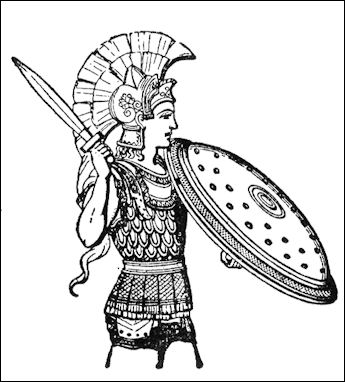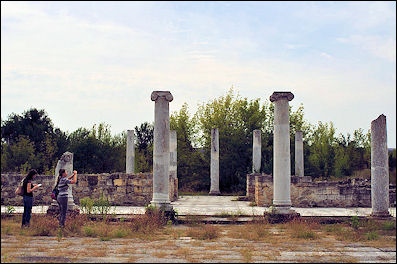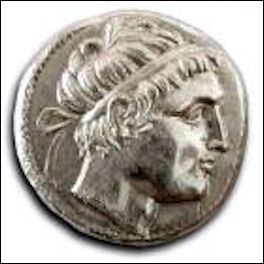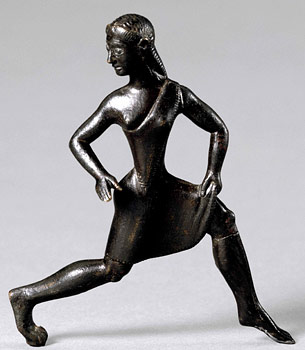SPARTANS
 Sparta was one of the greatest city-states of ancient Greece and for a long time the main rival of Athens. Unlike Athens which became a large power by way of trade and naval supremacy, Sparta rose through its military might and bravery. It was said that while Athens was centered around great buildings, Sparta was built by courageous men who “served their city in the place of walls of bricks."
Sparta was one of the greatest city-states of ancient Greece and for a long time the main rival of Athens. Unlike Athens which became a large power by way of trade and naval supremacy, Sparta rose through its military might and bravery. It was said that while Athens was centered around great buildings, Sparta was built by courageous men who “served their city in the place of walls of bricks."
The Spartan army was small. It was the only professional force in Greece. In Sparta every grown male was a soldier granted a farm run by slaves. The Spartans army was trained to fight in a phalanx, using a tight gird of overlapping shields to form an impenetrable mobile unit.
Herodotus wrote the Spartans fought "with swords, eyes, and with their hands and their teeth." Plato, Napoleon and Kurt Hahn, the founder of the Gordonstoun school, where Prince Charles studied, were inspired by the brutal discipline of the ancient Spartans.
Menelaus, the King of Sparta, was the husband of Helen, who was lured by Paris to Troy, causing the Trojan War. After the Trojans were defeated Helen was brought pack to Sparta. The Spartans built a shrine toher Helen where pregnant women went to pray for children who were not deformed. Herodotus described how Athena once appeared at the temple and told an ugly girl there that she would become a beautiful woman.
Book: The Spartans: The World of the Warrior-Heroes of Ancient Greece by Paul Cartledge, a professor at Cambridge University
History of the Spartans
.jpg)
Spartan shield (425 BC)Sparta began as a small city state with five villages. It later grew into a larger one by first gobbling up surrounding villages and then conquering neighboring large states and eventually claiming nearly all the Peloponnese, and enslaving many of the people that lived there to acquire land.
By 650 B.C., Sparta was one of the most powerful city-state in Greece. Admired and feared, it was ruled by a warrior caste and employed a full-time army that was created to quell revolts but was later was used in military campaigns of conquest.
Sparta subjugated an area of the western Peloponnese and forced its people to become Sparta's helots , or serfs. By some estimates the helots outnumbered Spartans by 10 to 1. The Messenians, who greatly outnumbered Spartans, once revolted only to be brutally put down by the Spartans. After that the Spartans vowed to never let a similar situation occur again and established a totalitarian state.
Sparta controlled more territory than any other city-state. It became so powerful that the only way it could be controlled was through alliances formed by the major Greek powers---Argos, Athens, Corinth and Thebes. Sparta eventually crumbled in 362 B.C., when its army was defeated by the Thebians at the great Battle of Mantinea.
Spartan Values

Spartan swordmanIn ancient Sparta strength was admired and weakness was despised. The greatest virtue was bravery and the greatest honor was to die fighting in battle. The most serious crime for a Spartan was to retreat from battle. Endurance, putting up with pain without complaining and following orders without questioning were all traits that were greatly esteemed. The Spartan poet Tyrtaios wrote: "It is a novel thing for a good man to die...fighting for his fatherland. Make life your enemy, and the black spirits of death does as the rays of the sun."
Mothers gave their sons a shield and said, “Bring back this shield or be brought back on it," a reference to the way the dead were carried from the battlefield. Greek historians described how the relatives of soldiers killed in battle celebrated while the wives of men who survived look depressed. Men who returned from a battle were ostracized if they were seen smiling and one "coward" was even killed by his own mother.
The only two survivors of the Battle of Thermopylae, in which the Spartans saved Greece from a Persian attack, were so humiliated they committed suicide on their return to Sparta. One Spartan boy reportedly ashamed to reveal that he was hiding a fox underneath his cloak let the fox rip out his stomach.
Spartan State

ruins of ancient SpartaThe Spartan state was considered much more important than the rights and lives of individual citizens. Individual Spartans were regarded as property of the state from the moment they were born and they were expected to give their lives for the state. The Spartan government regimented daily life. Weak babies were left to die, education was like boot camp and marriage was regarded as interruption on the road to comradeship.
Sparta was ruled by two kings, who served jointly, with each acting as a check on the other and their power was checked by the Ephor, a group of five annually elected overseers. The kings served as high priests and led men in war. There was also an assembly, a cabinet-like council of generals and a council of elders.
The were three classes in Sparta: 1) Citizens-soldiers, the only people with political rights; 2) traders and merchants, who lived in surrounding villages and had no political rights; and 3) slaves, who mostly worked the land and were treated brutally by their masters. slaves that were killed were usually tagged as unreliable.
Historians have suggested the Spartans were so fierce and brutal because the 8,000 male-citizens were vastly outnumbered by the slaves they controlled. To keep the lower caste intimidated and in line young Spartan men were encouraged to go into the countryside once a year and kill any slaves they saw.
Spartan Lifestyle
The word Spartan, which has come to mean disciplined and austere, was derived from the Spartans regimented life and lack of material comforts. Spartans dressed in course clothes. Their meals consisted primarily of porridge and black soup made with pigs blood. An Athenian pundit once joked that observing how the Spartans lived made him understood why they were so eager to die in battle.
Sparta was more like an armed camp than a city. The men carried their weapons with them at all times and ate in mess halls together. The primary duty of Spartan wives was to produce future soldiers and wife swapping was permissible as long as it furthered this goal.

Spartan's monument
Men were not allowed to own silver or gold. Spartan money was iron bars. Music consisted primarily of war-songs to which men danced with their armor to increases their strength. Conversation was kept to a minimum. People were expected to say little and get to the point. The word laconic comes from Spartan city of Laconia.
Spartan Training
Spartan training began in the womb. A pregnant woman was required to do exercises to make sure her child was strong, The Spartans checked newborn infants for physical deformities and mental problems; if an abnormality was discovered the child was tossed off a cliff.

Areus I King of SpartaSpartan boys were taken from the mothers at the age of seven and moved into barracks and taught to be men until they were aged 20. The new recruits were bullied by older boys, forced to play brutal games and walk barefoot in the winter, and were ritually flogged in a temple devoted to the goddess of the hunt. Those that did well were made leaders. Young boys were paired with older boys in a relationship that had homosexual overtones. Plutarch wrote: “They were favored with the society of young lovers among the reputable young men...The boy lovers also shared with them in their honor and disgrace."
The training was mostly in the form of physical drills and the martial arts. There was not so much instruction in philosophy, music or literature as was the case a the famous academies in Athens. Sometimes boys were purposely left hungry so they would steal food and develop shrewdness and resourcefulness.
When a boy reached 18, they were trained in combat. At twenty they moved into a permanent barrack-style living and eating arrangement with other men. They married at any time, but lived with men. At 30 they were elected to citizenship.
Spartan Women, Sex and Weddings

Spartan womanSpartan women had more freedoms and rights than other Greek women. Plutarch wrote that Spartan marriage was matrilocal and that "women ruled over men."
Spartan women were almost as tough as the men. They worked out by by running, wrestling and exercising so they could "undergo the pains of childbearing." Girls were trained in athletics, dancing and music. They lived at home, while boys lived apart in their barracks. As adults, women participated in their own athletic events and performed naked like the men.
In Sparta women competed in front of the men nude in "gymnastics," which at that times meant "exercises performed naked." The Spartan women also wrestled but there is no evidence that they ever boxed. Most events required the women to be virgins and when they got married, usually the age of 18, their athletic career was over. [Source: "The Creators" by Daniel Boorstin,"]
In Sparta, the bride was usually kidnapped, her hair was cut short and she dressed as a man, and laid down on a pallet on the floor. "Then," Plutarch wrote, "the bride groom...slipped stealthily into the room where his bride lay, loosed her virgin's zone, and bore her in his arms to the marriage-bed. Then after spending a short time with her, he went away composedly to his usual quarters, there to sleep with the other men." [Source: "Greek and Roman Life" by Ian Jenkins from the British Museum,"|]
Homosexuality appears to have been the norm for both men and women with more than a touch of sadomasochism thrown in. The Spartans believed that beating was good for the soul. Heterosexual sex was primarily just to have babies. There was also a lot of inbreeding. Spartan King Leonidas, the main character in the film 300 , was the product of an uncle-niece marriage and his wife Gorgo was the daughter of his half brother.
The Film 300
The film 300 went a long way in introducing the Spartans and their ethos to the modern general public. Although the New York Times called the film excessively violent and stupid it gave viewers some insight into the harsh training the Spartans endured to make them as tough and fierce as they were and showed how that paid off the Greeks in the Spartans’ heroic defense at Thermopylae in 480 B.C.
300 was shot almost exclusively in a Montreal warehouse, using blue screen graphics and imagery. Earning more than $500 million at the box office globally, it was based on a Frank Miller graphic novel which in turn was inspired by the 1962 film 300 Spartans .
Image Sources: Wikimedia Commons, The Louvre, The British Museum
Text Sources: New York Times, Washington Post, Los Angeles Times, Times of London, Yomiuri Shimbun, The Guardian, National Geographic, The New Yorker, Time, Newsweek, Reuters, AP, Lonely Planet Guides, Compton's Encyclopedia and various books and other publications. Most of the information about Greco-Roman science, geography, medicine, time, sculpture and drama was taken from "The Discoverers" [∞] and "The Creators" [μ]" by Daniel Boorstin. Most of the information about Greek everyday life was taken from a book entitled "Greek and Roman Life" by Ian Jenkins from the British Museum [||].
No comments:
Post a Comment